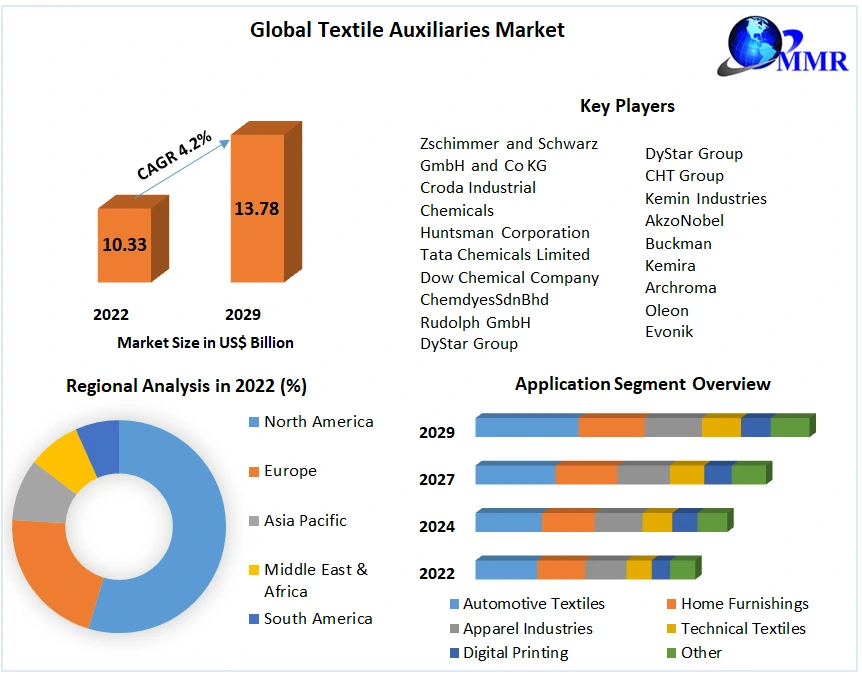Global Textile Auxiliaries Market Poised for Significant Growth by 2029
The Global Textile Auxiliaries Market Trend is on a trajectory of substantial growth, with its valuation reaching US$ 10.33 billion in 2022 and projected to ascend to US$ 13.78 billion by 2029, reflecting a Compound Annual Growth Rate (CAGR) of 4.2% during the forecast period. This expansion is driven by technological advancements, evolving consumer preferences, and the burgeoning demand for high-quality textile products.
For in-depth information on this study, visit the following link:
https://www.maximizemarketresearch.com/request-sample/63608/
Market Definition and Estimation
Textile auxiliaries are essential chemical agents utilized throughout various stages of textile production, including pre-treatment, dyeing, printing, and finishing processes. These agents enhance the fabric's aesthetic appeal, functional properties, and overall quality. The market's valuation of US$ 10.33 billion in 2022 underscores the critical role these auxiliaries play in the textile industry, with projections indicating a rise to US$ 13.78 billion by 2029, at a CAGR of 4.2%.
Growth Drivers and Opportunities
Several factors are propelling the growth of the textile auxiliaries market:
-
Technological Innovations: Advancements in textile printing and dyeing technologies have streamlined production processes, leading to increased efficiency and reduced environmental impact. Innovations such as digital printing and eco-friendly dyeing methods have expanded the application scope of textile auxiliaries.
-
Rising Consumer Demand: There is a growing consumer inclination towards high-quality, durable, and aesthetically pleasing textile products. This demand has prompted manufacturers to incorporate advanced auxiliaries that enhance fabric properties, including colorfastness, texture, and longevity.
-
Sustainability Trends: Environmental concerns have led to a shift towards eco-friendly and sustainable textile production. Auxiliaries that reduce water consumption, energy usage, and chemical waste are gaining traction, offering lucrative opportunities for market players focusing on green chemistry solutions.
-
Expansion of the Apparel Industry: The global apparel sector's growth, fueled by fashion trends and increased disposable income, has escalated the demand for textile auxiliaries. Specialized clothing segments, such as sportswear and activewear, require auxiliaries that impart specific functionalities like moisture management and antimicrobial properties.
To explore further details about this research, please go to:
https://www.maximizemarketresearch.com/request-sample/63608/
Segmentation Analysis
The textile auxiliaries market is segmented based on product type and application:
-
By Product Type:
- Pre-Treatment Agents: Chemicals used to prepare fabrics for subsequent processes, ensuring uniform dye uptake and fabric smoothness.
- Dyeing & Printing Agents: Auxiliaries that facilitate color application, improve dye penetration, and ensure colorfastness.
- Finishing Agents: Compounds that impart desired properties such as softness, wrinkle resistance, water repellency, and flame retardancy to the final textile product.
- Spinning & Weaving Agents: Lubricants and antistatic agents that enhance fiber processing during spinning and weaving operations.
-
By Application:
- Apparel: Dominating the market, this segment includes casual wear, formal wear, sportswear, and intimate apparel. The demand for fashionable and functional clothing drives the need for specialized auxiliaries.
- Home Furnishing: Encompasses textiles used in home décor, such as upholstery, curtains, bed linens, and carpets. Auxiliaries in this segment focus on durability, aesthetic appeal, and maintenance ease.
- Technical Textiles: Includes textiles designed for industrial applications, medical textiles, automotive textiles, and protective clothing. These require auxiliaries that provide specific functionalities like fire resistance, antibacterial properties, and enhanced mechanical strength.
Regional Insights
-
United States: As a significant player in the textile market, the U.S. exhibits a steady demand for textile auxiliaries. The country's focus on technological innovation and sustainable practices has led to the adoption of advanced auxiliaries that comply with environmental regulations. The presence of major apparel brands and a robust fashion industry further bolster market growth.
-
Germany: Renowned for its engineering excellence, Germany's textile industry emphasizes high-quality production and technological advancements. The demand for technical textiles in automotive and industrial applications has spurred the use of specialized auxiliaries. Additionally, stringent environmental standards in the European Union drive the adoption of eco-friendly textile processing solutions.
Competitive Landscape
The textile auxiliaries market is characterized by the presence of several key players striving to enhance their market position through innovation, strategic partnerships, and sustainability initiatives. Notable companies include:
-
Huntsman International LLC: A global leader offering a diverse portfolio of textile chemicals, Huntsman focuses on sustainable solutions and has introduced eco-friendly auxiliaries that reduce water and energy consumption during textile processing.
-
Archroma: Committed to innovation and performance, Archroma provides a wide range of auxiliaries designed to improve fabric quality and sustainability. Their emphasis on research and development has led to the creation of products that meet evolving industry demands.
-
DyStar Group: With a strong global presence, DyStar offers comprehensive textile solutions, including auxiliaries that enhance color vibrancy and fabric performance. Their dedication to environmental responsibility is evident through their sustainable product offerings.
-
Evonik Industries AG: Specializing in specialty chemicals, Evonik provides auxiliaries that cater to various textile applications, focusing on enhancing process efficiency and product quality.
-
Kemin Industries: Known for their expertise in biotechnology, Kemin offers innovative textile auxiliaries that impart unique functionalities, such as antimicrobial properties, to fabrics.
About Us:
Maximize Market Research is one of the fastest-growing Market research and business consulting firms serving clients globally. Our revenue impact and focused growth-driven research initiatives make us a proud partner of majority of the Fortune 500 companies. We have a diversified portfolio and serve a variety of industries such as IT & telecom, chemical, food & beverage, aerospace & defense, healthcare and others.
Contact Us:
MAXIMIZE Market RESEARCH PVT. LTD.
3rd Floor, Navale IT park Phase 2,
Pune Banglore Highway, Narhe
Pune, Maharashtra 411041, India.
+91 9607365656

Comments on “extile Auxiliaries Market Set for Steady Growth: Projected to Hit $13.78Bn by 2029”